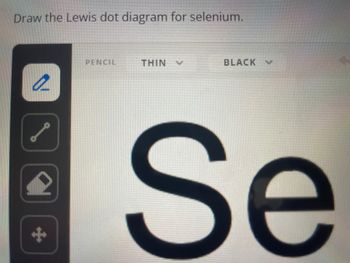
Living By Chemistry: First Edition Textbook
1st Edition
ISBN: 9781559539418
Author: Angelica Stacy
Publisher: MAC HIGHER
expand_more
expand_more
format_list_bulleted
Question

Transcribed Image Text:**Drawing the Lewis Dot Diagram for Selenium**
To accurately represent the Lewis dot structure for selenium, follow these steps:
1. **Identify the Element Symbol:** Selenium is denoted by the symbol "Se."
2. **Determine the Valence Electrons:** Selenium is in group 16 of the periodic table, indicating it has six valence electrons.
3. **Draw the Electron Dots:**
- Place the symbol "Se" for selenium in the center.
- Around the symbol, arrange the six valence electrons as dots. These should be positioned as single dots on each of the four sides, with one pair on any two of the sides, to represent the distribution of electrons.
The Lewis dot diagram visually represents the valence electrons of an element, which helps in understanding chemical bonding and molecular structure.
Expert Solution
This question has been solved!
Explore an expertly crafted, step-by-step solution for a thorough understanding of key concepts.
This is a popular solution
Trending nowThis is a popular solution!
Step by stepSolved in 2 steps with 1 images

Knowledge Booster
Learn more about
Need a deep-dive on the concept behind this application? Look no further. Learn more about this topic, chemistry and related others by exploring similar questions and additional content below.Similar questions
- 2.26 In what region of the periodic table are you likely to find elements that form more than one stable ion?arrow_forwardUse the periodic table shown in Fig. 4.9 to find the symbol or name for each of the following elements. Symbol Name Co rubidium Rn radiumarrow_forwardNeutral F atom gains one electron to form: . Neutral Mg atom loses two electrons to form:arrow_forward
- Can you help me solve these questions please?arrow_forwardQuestion in photo.arrow_forwardCharge imbalance on the atomic scale. a) If you come across a lone neon atom, is it likely to have an equal number of protons and electrons? Explain your answer. b) If you find yourself a lone iodine atom, is it likely to have an equal number of protons and electrons? Explain your answer.arrow_forward
- Subject: chemistryarrow_forwardOn the subject of the element Sulfur : A) How many valence electrons does Sulfur have? B) How many total electrons does Sulfur have? C) How many protons does Sulfur have? D) What is the complete electron configuration of Sulfur ?arrow_forwardPlease help with questions 1-4 and 6.arrow_forward
- Please complete the following question. There is no need to provide an explaination. 2arrow_forward4. Write the symbol of: a) an ATOM whose electron configuration ENDS with 4p5: b) an ANION whose electron configuration ENDS with 3pº: c) a CATION whose electron configuration ENDS with 3p6: d) an ATOM whose electron configuration ENDS with 7s²:arrow_forwardElements found in the ________ period of the periodic table, can never have more than 8 electronsarrow_forward
arrow_back_ios
SEE MORE QUESTIONS
arrow_forward_ios
Recommended textbooks for you
 Living By Chemistry: First Edition TextbookChemistryISBN:9781559539418Author:Angelica StacyPublisher:MAC HIGHER
Living By Chemistry: First Edition TextbookChemistryISBN:9781559539418Author:Angelica StacyPublisher:MAC HIGHER Introductory Chemistry: An Active Learning Approa...ChemistryISBN:9781305079250Author:Mark S. Cracolice, Ed PetersPublisher:Cengage LearningChemistry: Matter and ChangeChemistryISBN:9780078746376Author:Dinah Zike, Laurel Dingrando, Nicholas Hainen, Cheryl WistromPublisher:Glencoe/McGraw-Hill School Pub Co
Introductory Chemistry: An Active Learning Approa...ChemistryISBN:9781305079250Author:Mark S. Cracolice, Ed PetersPublisher:Cengage LearningChemistry: Matter and ChangeChemistryISBN:9780078746376Author:Dinah Zike, Laurel Dingrando, Nicholas Hainen, Cheryl WistromPublisher:Glencoe/McGraw-Hill School Pub Co
 Chemistry for Engineering StudentsChemistryISBN:9781337398909Author:Lawrence S. Brown, Tom HolmePublisher:Cengage Learning
Chemistry for Engineering StudentsChemistryISBN:9781337398909Author:Lawrence S. Brown, Tom HolmePublisher:Cengage Learning Introductory Chemistry: A FoundationChemistryISBN:9781337399425Author:Steven S. Zumdahl, Donald J. DeCostePublisher:Cengage Learning
Introductory Chemistry: A FoundationChemistryISBN:9781337399425Author:Steven S. Zumdahl, Donald J. DeCostePublisher:Cengage Learning

Living By Chemistry: First Edition Textbook
Chemistry
ISBN:9781559539418
Author:Angelica Stacy
Publisher:MAC HIGHER

Introductory Chemistry: An Active Learning Approa...
Chemistry
ISBN:9781305079250
Author:Mark S. Cracolice, Ed Peters
Publisher:Cengage Learning

Chemistry: Matter and Change
Chemistry
ISBN:9780078746376
Author:Dinah Zike, Laurel Dingrando, Nicholas Hainen, Cheryl Wistrom
Publisher:Glencoe/McGraw-Hill School Pub Co


Chemistry for Engineering Students
Chemistry
ISBN:9781337398909
Author:Lawrence S. Brown, Tom Holme
Publisher:Cengage Learning

Introductory Chemistry: A Foundation
Chemistry
ISBN:9781337399425
Author:Steven S. Zumdahl, Donald J. DeCoste
Publisher:Cengage Learning